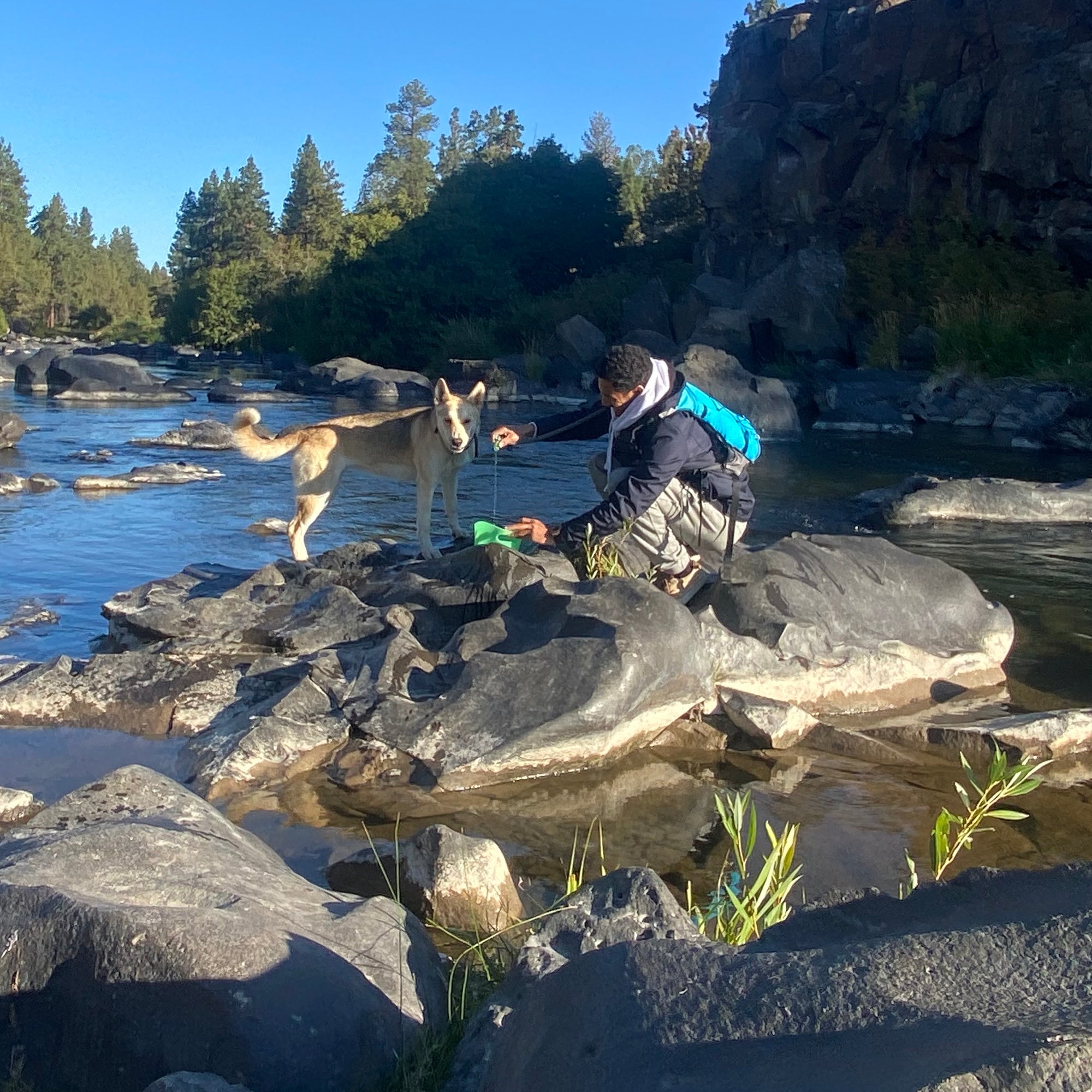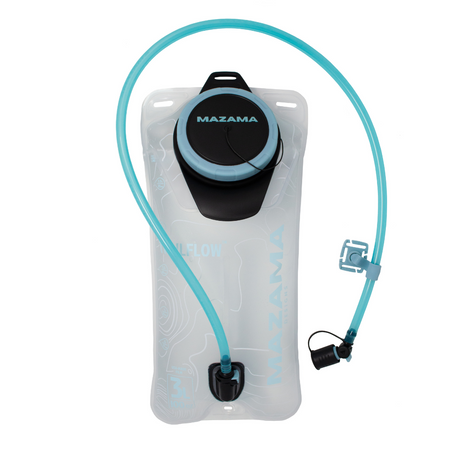Keeping Your Dog Hydrated on the Trail
September 07 2021 – Matt Hoskins

Whether you’re hiking, running, or riding, time on the trail with your dog can be a lot of fun. As these excursions often involve longer distances, more exertion, and less predictability than on neighborhood walks, it’s worth making sure you’ve got you and your pup’s hydration needs covered.

How much water you’ll need to bring for you and your dog depends on the level of activity, weather, and your dog’s size. Dogs require anywhere from ½ oz to 1.5 oz per pound of body weight per day so if you’ve got a larger dog and you’re on a multi-hour hike, it’s certainly possible that you’ll need the full contents of a 2- or 3-liter reservoir.
The risk of dehydration, like most dog-related activities, can be mitigated with a little planning, preparation, and of course some dog-specific gear.
Understand your dog’s fitness level:
You’ll need to match the excursion to your dog’s fitness level, making sure you’re not biting off more than you can chew. If you get too far out and your pup gets injured, will you be able to carry her out? Is there cell phone service where you’re exploring in case of emergency? All of these factors are important to consider -- don’t be afraid to start slow and build up to bigger and longer adventures with your dog.
Check the forecast & the route:
Hot and cold weather along with extra dry air all pose a dehydration risk. If it’s hot, you may want to choose a route that has shady sections and/or go earlier in the day. Check the trail conditions and if it’s an unfamiliar area, consult a map. As most of us have experienced, one wrong turn can add hours to a hike or ride depleting your water supply along the way. Higher elevations affect stamina and dehydration rate as well.

Plan how much water to bring:
Based on your own experience and the rough guideline above, estimate how much water you and your dog will require. While many dogs can drink from streams and lakes without problems, if present, giardia and other microorganisms can sicken dogs just like humans. While it’s tempting to think of nearby lakes and streams as back-up water sources for your dog, the best practice is to carry enough clean water to cover anticipated needs. For longer hikes and backpacking trips, bringing a water filter is going to be the ticket and you’ll want to plan around hitting water sources along your route.
Utilize your preferred carrying and dispensing solution:
Here’s where you and your dog both get involved. There’s you and how you want to transport the water and hydrate yourself, and then there’s your dog who may have a certain drinking style and could be perfectly happy carrying her own water (or not!). There are plenty of great options out there and you can choose what works best for you and your dog. Among the options:
Collapsible bowls filled via a water bottle or reservoir
Collapsible bowls are easy to carry, and they usually conform to uneven ground so they aren’t prone to spilling. Wearing a pack with a reservoir is going to provide a larger volume of fluid and storage space for other trail essentials. If there's a handy pocket for the bowl, you can simply pull out the bowl and fill it via the reservoir’s drink tube. Make sure you’ve got gravity working with you, then squeeze the bite valve with your fingers to initiate flow. If you're using Mazama’s GYZR valve, just rotate the bite valve sheath for streaming flow. One of our favorite collapsible bowls, from our Bend neighbor, is Silipint's 1 L foldable, silicone dog bowl.

Dog packs
To each his own is one approach and there are a variety of dog packs that will allow your dog to carry their own water. Make sure the pack is a good fit and practice with it empty or with lighter loads before hitting the trail. In general, a young/healthy dog can carry about 25% of their body weight. Collapsible bottles that fit into the dog pack’s side pockets are a convenient water carrying option.
Bowl and bottle combos
Bowl-bottle products where the bowl is integrated and nests around a water bottle are another useful hydration option for your pet. These take up about the same space as a regular bottle and work for both human and dog.
Dispensing systems
Bottles with special spouts are another solution. These come with a dog-friendly spout so that your dog can drink directly from the bottle.. Similarly, you can equip your reservoir with a pump system so that you or your dog can get a squirt without any cross-contamination. Mazama's Quikstream Pump connects to standard hydration reservoirs, allowing pressurized dispensing from your reservoir.
Insulated systems
Insulated reservoirs and bottles offer enhanced hydration for both you and your pet. On hot days, cold water will have a refreshing effect for both of you. If you’re adventuring in the winter, insulated containers are going to help forestall freezing of your water supply. Mazama offers an insulated model of its 2 L INTAKE reservoir and also sells a doublewall, vacuum insulated 20 oz bottle.
Take breaks & watch for signs of dehydration:
Building rest and snack breaks into your hike or ride benefit man and beast alike. This is especially helpful when you first start going on longer ventures with your pet and their endurance level is not yet known.. When you’re out in hot (and extra cold) temps you’ll certainly want to keep an eye out for signs of fatigue and thirst in your pet. Early signs of dehydration include rapid panting, drooling, and stalling. If your dog is becoming lethargic and exhibits sunken eyes and a dry nose and mouth, stop and rest and provide her with a drink. Keeping yourself properly hydrated is essential as well. Your dog is relying on you to make good decisions and get the both of you back to the start point.

Wilderness excursions with your dog are a great way to exercise and bond with your pet. Hydration is just one of the issues that you’ll need to think through and handle--make sure you’re up-to-speed on trail requirements, who and what you might encounter, nutrition and waste management needs, and first aid and emergency considerations. With planning and alertness, it can all be managed and you and your dog can have a rich and rewarding experience on the trail.

